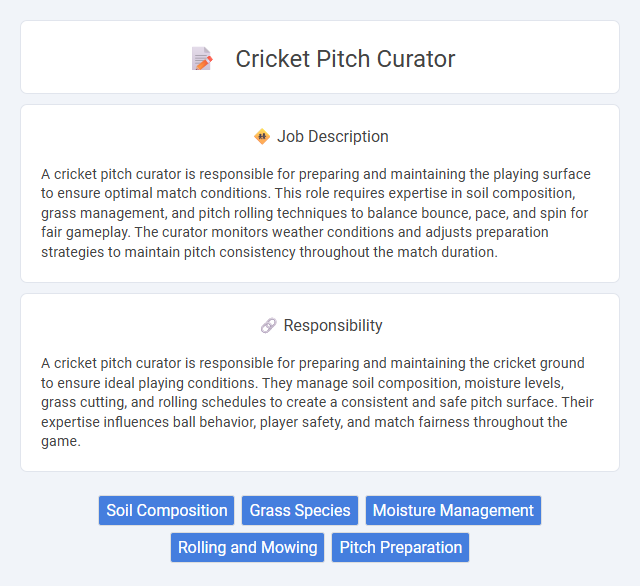
A cricket pitch curator is responsible for preparing and maintaining the playing surface to ensure optimal match conditions. This role requires expertise in soil composition, grass management, and pitch rolling techniques to balance bounce, pace, and spin for fair gameplay. The curator monitors weather conditions and adjusts preparation strategies to maintain pitch consistency throughout the match duration.
Individuals with a strong interest in agriculture, soil science, and outdoor work are likely suitable for a cricket pitch curator role, as it demands physical stamina and attention to detail in pitch maintenance. People who prefer routine tasks and have patience for long hours of monitoring pitch conditions may find this job fulfilling. However, those who are uncomfortable working in varying weather conditions or lack an interest in sports turf management might struggle to adapt effectively to this position.
Qualification
A Cricket pitch curator typically requires a strong background in agronomy, turf management, or sports ground maintenance, often supported by a diploma or degree in these fields. Practical experience in soil analysis, drainage systems, and pitch preparation techniques is crucial for ensuring high-quality playing surfaces. Certifications in turf science or groundskeeping further enhance a curator's qualifications and expertise in pitch maintenance.
Responsibility
A cricket pitch curator is responsible for preparing and maintaining the cricket ground to ensure ideal playing conditions. They manage soil composition, moisture levels, grass cutting, and rolling schedules to create a consistent and safe pitch surface. Their expertise influences ball behavior, player safety, and match fairness throughout the game.
Benefit
A cricket pitch curator likely enjoys the benefit of contributing to the quality and fairness of the game by preparing and maintaining optimal playing surfaces. This role probably offers a unique blend of outdoor work and technical skill development related to soil science and turf management. Opportunities for career growth in sports groundkeeping and collaboration with players and coaches may also be significant advantages.
Challenge
The role of a cricket pitch curator likely involves significant challenges related to balancing fair play conditions with weather variability and soil characteristics. Ensuring consistent pitch quality requires careful management of moisture levels, grass health, and surface hardness, which can be unpredictable due to environmental factors. The task probably demands constant monitoring and adjustment to maintain a playing surface that tests players while minimizing injury risks.
Career Advancement
A cricket pitch curator plays a vital role in preparing and maintaining high-quality playing surfaces that directly impact match outcomes and player performance. Career advancement opportunities include becoming a senior curator, ground manager, or consultancy roles with cricket boards and international venues, leveraging specialized knowledge in turf management and soil science. Gaining certifications in agronomy and experience with advanced pitch preparation technologies enhances prospects for leadership positions in sports facility management.
Key Terms
Soil Composition
A cricket pitch curator specializes in selecting and managing soil composition to optimize pitch performance and durability. Ideal soil for cricket pitches typically contains a balanced mix of clay, silt, and sand, with clay content around 30-40% to provide firmness and bounce consistency. Proper soil moisture and compaction are meticulously controlled to ensure uniform pitch conditions and enhance player safety.
Grass Species
A cricket pitch curator specializes in selecting and maintaining grass species that optimize playing conditions, durability, and ball behavior. Commonly used grass types include Bermuda grass, known for its resilience and fast growth, and ryegrass, favored for its fine texture and recovery rate. Proper grass selection directly impacts pitch hardness, moisture retention, and overall match performance.
Moisture Management
A cricket pitch curator specializes in moisture management to ensure optimal playing conditions by controlling soil hydration levels and drainage systems. Precise moisture regulation affects ball bounce, pace, and spin, directly influencing match quality and player safety. Advanced techniques include monitoring soil moisture content through sensor technology and adjusting watering schedules based on weather forecasts and pitch usage.
Rolling and Mowing
A cricket pitch curator is responsible for maintaining the quality and playability of the playing surface, with rolling and mowing being crucial tasks. Rolling compacts the soil, ensuring a firm and even pitch that offers consistent bounce and pace, while mowing controls the grass height to balance traction and ball movement. Precise timing and technique in both rolling and mowing directly impact match conditions and player performance.
Pitch Preparation
A cricket pitch curator specializes in preparing and maintaining the playing surface to ensure optimal conditions for matches. This involves soil composition analysis, watering schedules, grass cutting, and rolling techniques to balance bounce, pace, and spin for fair gameplay. Expertise in weather impact and pitch wear management is crucial for consistent pitch quality throughout a tournament.
 kuljobs.com
kuljobs.com